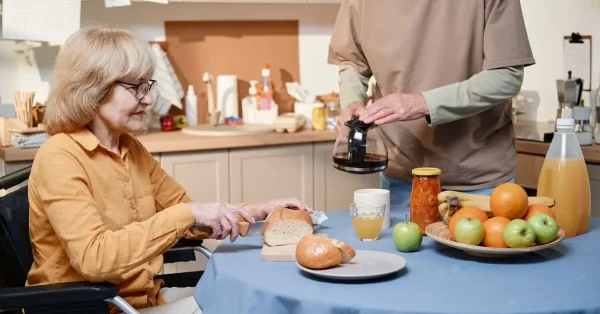Over half of all stroke survivors experience a stroke affecting speech. When a stroke affects speech or language, it can impact the ability to communicate effectively due to changes in cognitive language skills or speech-related motor abilities. This can affect the survivor’s ability to express their needs and desires, connect with family members, and return to work.
Conditions such as aphasia, dysarthria, or apraxia of speech are common following stroke. To learn more about these conditions and their treatments, this article will explain what happens after a stroke affecting speech and how to pursue recovery. Use the links below to jump directly to any section.
- Types of communication problems after stroke
- How to recover speech after stroke
- Exercises and techniques to improve speech
- How long does speech recovery take?
Types of Communication Problems After Stroke
According to a 2020 study of nearly 90,000 stroke survivors, 64% of individuals experience communication problems after a stroke. There are three main conditions that affect the ability to communicate following a stroke:
- Aphasia: difficulty with verbalizing thoughts or understanding others
- Dysarthria: weakness or incoordination of muscles involved with speech
- Apraxia of speech: difficulty with the brain telling the muscles how to move when speaking
After a stroke affecting speech, individuals may experience one or more of these conditions, depending on which area of the brain was affected. These conditions are explained in greater detail below.
Aphasia
Aphasia is characterized by difficulties producing and/or comprehending speech due to an impairment in the cognitive skill of language. Individuals with aphasia have the ability to physically produce speech, but have trouble with cognitively producing or understanding language. It may also affect the ability to read and write.
Aphasia is often the result of a left hemisphere stroke. This is because the two primary language centers of the brain typically reside in the left hemisphere. These language centers include Broca’s area, which is associated with producing language, and Wernicke’s area, which is associated with comprehending language.
There are many types of aphasia, which can be broken down into the following categories:
- Broca’s aphasia (sometimes referred to as expressive aphasia): difficulty with spoken and written expression
- Anomic aphasia: difficulty with word retrieval, may demonstrate slow, halting speech
- Wernicke’s aphasia (sometimes referred to as receptive aphasia or fluent aphasia): difficulty understanding speech and trouble with producing meaningful speech; able to speak long, fluent sentences, but words do not make sense
- Conduction aphasia: difficulty with repeating words or phrases
- Global aphasia: difficulties with both speech production and comprehension
While these are among the most common types of aphasia after stroke, there are also other aphasias. These include transcortical sensory aphasia, transcortical motor aphasia, and mixed transcortical aphasia.
Dysarthria
Dysarthria occurs when brain or nerve damage results in weakness, incoordination, and/or abnormal tone of the muscles involved in speaking. This may cause individuals with dysarthria to sound like they are slurring their words or mumbling.
Symptoms of dysarthria include:
- Speaking in way that is incomprehensible or difficult to understand
- Unnatural sounding speech, possibly robotic or choppy
- Speaking too loudly or quietly, or at a fast or slow pace
- Speech may sound breathy, hoarse, or nasally
- Difficulty moving the lips, jaw, and/or tongue
Unlike aphasia, dysarthria is considered a motor speech disorder. It may be caused by damage to a number of areas, including the pons, corona radiata, cerebellum, or areas within or surrounding the motor cortex.
Apraxia of Speech
In order to speak, the brain has to tell the muscles involved with speaking how to move. For those with apraxia of speech, these messages get disrupted on their way from the brain to the speech-related muscles. Therefore, these individuals do not have accurate voluntary control of the muscles related to speech, such as the lips and tongue.
Even though individuals with apraxia of speech know what they want to say, they often have difficulty producing the desired sounds needed to speak specific words. For example, they may say, “chicken” instead of “kitchen”, or use a completely different word entirely.
Symptoms of apraxia of speech include:
- Difficulty producing or repeating desired sounds
- Inconsistent speech errors, such as being able to say something accurately one time, but incorrectly the next
- Groping for sounds by effortfully moving the lips and tongue or trying multiple times
- Speaking slowly or not at all
- Intact automatic speech, such as saying “Hi, how are you?”, since this is stored in a different area of the brain
- Altered speech rhythm or tone
Similar to dysarthria, apraxia of speech is a motor speech disorder. While researchers are still determining the exact areas of the brain involved, damage to Broca’s area, a specific portion of the left insula, and/or the premotor cortex may lead to apraxia of speech. Apraxia of speech and aphasia often occur together, which may make communication very difficult.
Every type of language difficulty is treated with different rehabilitation techniques. This is why it is important to work with a specialist that can help diagnose the type(s) of language difficulties a survivor is experiencing and create a personalized treatment plan.
How to Recover From a Stroke Affecting Speech
Recovering speech after stroke requires neuroplasticity, the brain’s ability to create new pathways and strengthen old ones after a stroke. When a stroke affects speech, skills that are lost, such language, muscle strength, and motor coordination, can be restored by creating new neural networks in the brain.
The key to activating neuroplasticity is repetition. When an affected function, such as language expression, is practiced consistently, the brain perceives a demand for that function. This can result in adaptive rewiring, allowing a healthy area of the brain to assume control over that function.
A great way to activate neuroplasticity is working with a speech-language pathologist, also known as a speech therapist. These professionals are able to evaluate speech, language and communication skills to determine which skills are affected and develop a customized treatment plan.
A speech therapist may use a number of exercises and treatment techniques during therapy. They may also encourage individuals to continue practicing the skills learned during therapy at home through a home exercise program.
Exercises and Techniques Used to Recover Speech After Stroke
Speech therapy rehabilitative treatments differ depending on whether an individual has aphasia, dysarthria, apraxia of speech, or a combination of these. Here are some of the most common exercises and techniques that may be used during speech therapy to help individuals improve after a stroke affecting speech:
- Tongue and lip exercises to improve strength, coordination, muscle tone, and motor planning
- Naming therapy, including verbally labeling different pictures or matching words to pictures
- Family education to improve communication between the survivor and their family
- Singing therapy for individuals who cannot talk, which focuses on activating healthy areas in the right side of the brain to compensate for affected language skills on the left side
- Learning to compensate for speech and language difficulties by using non-verbal techniques or augmentative and alternative communication
- Supplemental treatments, such as non-invasive brain stimulation, acupuncture, medications, or neuromuscular electrical stimulation, can further enhance neuroplasticity and functional improvements
- Home programs, such as the CT Speech & Cognitive Therapy App, which can provide personalized and increasingly challenging speech and language exercises based on skill level
The best way for survivors to learn which exercises may be most effective for their specific strengths and needs is to work with a speech-language pathologist. Regardless of which exercises or techniques are recommended, it is important to remember that consistent practice is key for improvements.
Want to learn more about the CT Speech and Cognitive Therapy App? Get Started Here.
(Link opens a pop-up for uninterrupted reading.)
How Long Does Speech Recovery Take?
Speech recovery after stroke is highly individualized and difficult to predict. The rate of recovery depends on a number of factors, including the severity of the stroke and how persistently individuals work toward improving.
One study found that even by the time a survivor was discharged from the hospital, over half of survivors with aphasia experienced improved language skills, with many experiencing a complete recovery of language. By 6 months post-stroke, nearly 90% of survivors had improved, with 74% of survivors fully recovering their language skills.
While optimal stroke recovery generally occurs in the first few months following stroke, there is always hope for improvements. Individuals have been shown to improve functions years after stroke, so it is never too late to start pursuing recovery.
Overcoming Speech Problems After Stroke
Speech problems after stroke are often diagnosed as aphasia, dysarthria, or apraxia of speech. These conditions affect a number of different speech and language functions, making it difficult for survivors to communicate effectively.
It is best to work with a speech-language pathologist to discover which exercises and techniques may be most effective. Through consistent practice, there is always hope for regaining speech and language skills after stroke.










